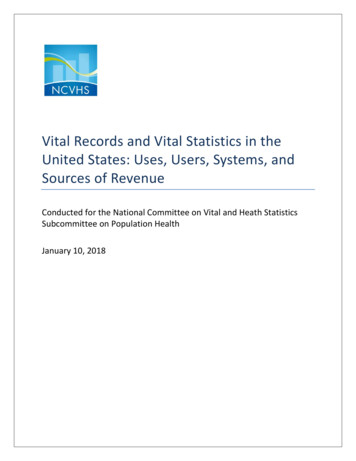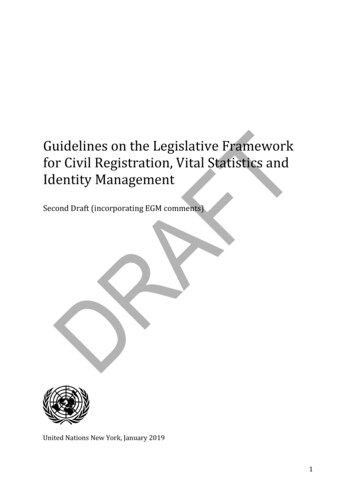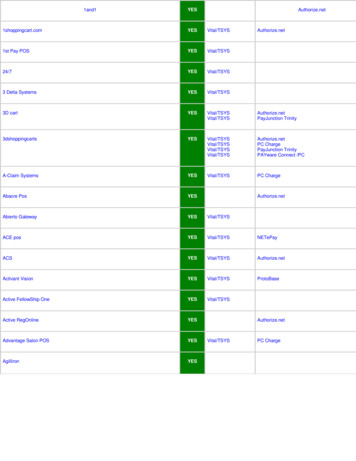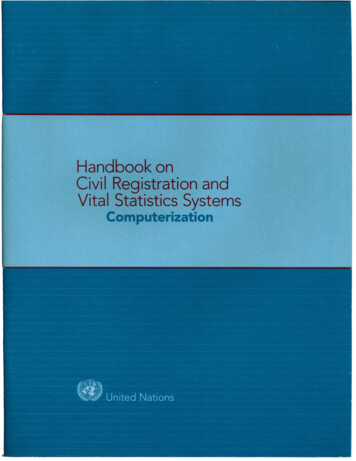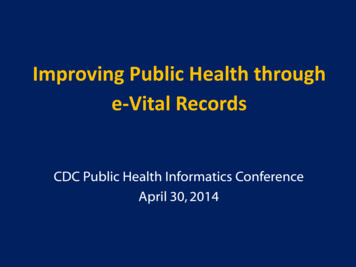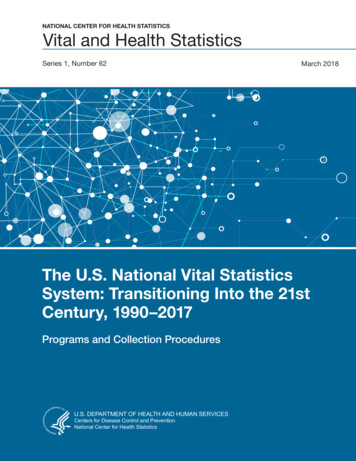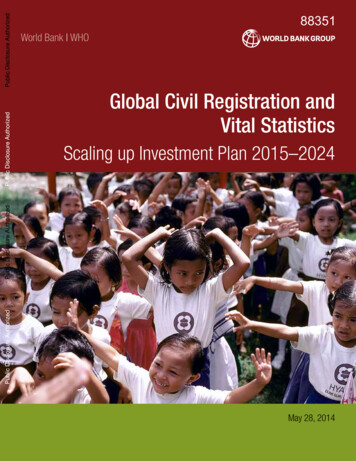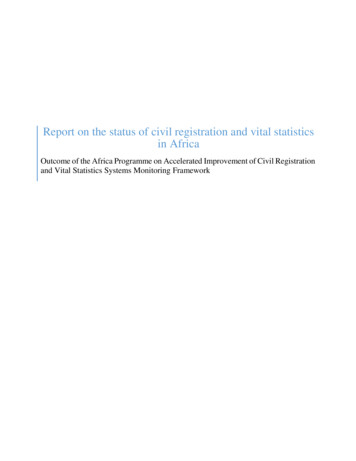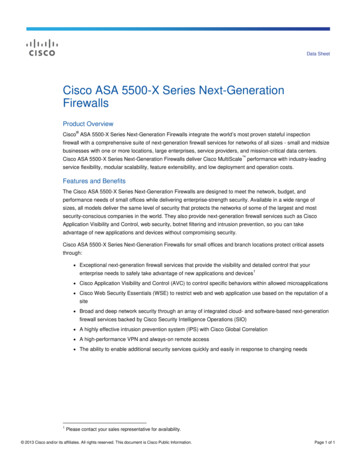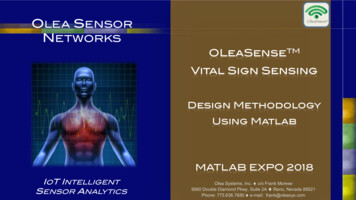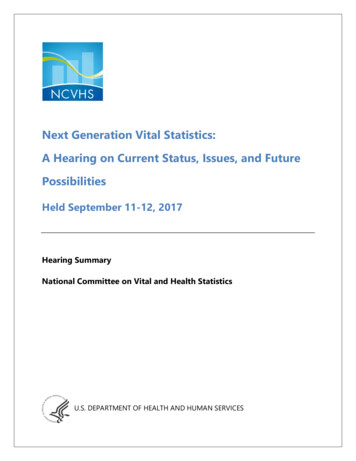
Transcription
Next Generation Vital Statistics:A Hearing on Current Status, Issues, and FuturePossibilitiesHeld September 11-12, 2017Hearing SummaryNational Committee on Vital and Health StatisticsU.S. DEPARTMENT OF HEALTH AND HUMAN SERVICES
NCVHS Next Generation of Vital Statistics Hearing Summary2This report was written by NCVHS consultant writer Susan Baird Kanaan, in collaboration withNCVHS members and staff.NCVHS Membership and Lead StaffWilliam W. Stead, MD, NCVHS ChairBruce B. Cohen, PhD,* Subcommittee Chair and Hearing Co-chairRobert L. Phillips, Jr., MD, MSPH, Subcommittee ChairDavid A. Ross, ScD*, Hearing Co-chairLlewellyn J. Cornelius, PhD*Alexandra GossNicholas L. CoussouleLinda L. Kloss, MA, RHIA,Richard W. Landen, MPH, MBADenise E. Love *Vickie M. Mays, PhD, MSPH*Jacki Monson, JDDebra Strickland, MS*Roland J. Thorpe, Jr., PhD**Member of the Subcommittee on Population HealthThe Committee wishes to acknowledge Helga Rippen, MD, PhD, MPH, FACPM for her significantcontributions as a member of NCVHS and the Population Health Subcommittee leading up toand during the time of the hearing.Kate Brett, PhD, Lead Staff to the Subcommittee on Population HealthEpidemiologistNational Center for Health Statistics, CDC, HHSRebecca Hines, MHS, NCVHS Executive Secretary/DFOHealth ScientistNational Center for Health Statistics, CDC, HHSRashida Dorsey, PhD, MPH, NCVHS Executive Staff DirectorDirector, Division of Data Policy Senior Advisor on Minority Health and Health Disparities Officeof Science and Data Policy Office of the Assistant Secretary for Planning and Evaluation, HHS
NCVHS Next Generation of Vital Statistics Hearing Summary3The National Committee on Vital and Health Statistics(NCVHS) serves as the advisory committee to the Secretary of Health and Human Services (HHS)on health data, statistics, privacy, national health information policy, and the Health InsurancePortability and Accountability Act (HIPAA) (42U.S.C.242k[k]). The Committee also serves as aforum for interaction with interested private-sector groups on important health data issues. Itsmembership includes experts in health statistics, electronic interchange of healthcareinformation, privacy, confidentiality, and security of electronic information, population-basedpublic health, purchasing or financing healthcare services, integrated computerized healthinformation systems, health services research, consumer interests in health information, healthdata standards, epidemiology, and the provision of health services. Sixteen of the 18 membersare appointed by the HHS Secretary to terms of four years each. Two additional members areselected by Congress. For more information, visit the NCVHS website: www.ncvhs.hhs.gov.Issued May 2018
NCVHS Next Generation of Vital Statistics Hearing Summary4Table of ContentsExecutive Summary . 6ES-I. Introduction and Overview of the Hearing. 6ES-II. The Vital Records and Vital Statistics Landscape . 7ES-III. The Uses of Vital Record Data and Vital Statistics. 7ES-IV. System Challenges . 8ES-V. Looking to the Future . 10I. Introduction and Overview of the Hearing . 12II. The Vital Records and Statistics System Landscape . 14Vital Event Registration . 14Vital Statistics . 15Information Flow in a Federated System. 15III. The Uses of Vital Record Data and Vital Statistics . 18Health Care and Public Health . 19Population Estimates. 19Identity Establishment and Verification, Death Notification, Fraud Prevention . 20IV. System Challenges . 20Costs and Financing . 20Complexity, Inefficiency, and Gaps in Technology . 21Variability and Performance Gaps among Jurisdictions . 23Quality Concerns. 23Lack of Training for Data Providers and Collectors . 23Barriers to Data Access . 24Challenges Related to Mortality . 25V. Looking to the Future. 26Vision. 26Possible Strategies . 27Next Steps . 30Appendix 1. Hearing Agenda and Panelists . 31Appendix 2. Hearing Attendees. 43Appendix 3. One-Page Background on Hearing . 44
NCVHS Next Generation of Vital Statistics Hearing Summary5Appendix 4. National Committee on Vital and Health Statistics Membership. 45
NCVHS Next Generation of Vital Statistics Hearing Summary6Executive SummaryVital records data are the foundation for essential functions at local, state, territorial, andfederal levels but the system is highly vulnerable. Federal leadership is needed tomodernize and secure the vital records and vital statistics data collection network as asustainable, reliable resource.ES-I. Introduction and Overview of the HearingVital records, the building blocks for vital statistics, are the legal registration of major life eventsfor individuals, including birth, fetal death, marriage, divorce, and death. Vital statistics, thecompilation of de-identified vital records, are the quantitative data concerning vital events in apopulation, such as the number of births and the death rate. Together, the Vital Registration andStatistics System (VRSS), play a critical role in public health surveillance and evaluation of theeffectiveness of health care and health financing, and are relied on for identity establishment,research, commerce, and many other essential uses.The National Committee on Vital and Health Statistics (NCVHS), a Federal Advisory Committee,held a hearing in Washington, D.C., in September 2017 to review the nation’s existing VRSS andexplore how to transform it into a system that is more robust, integrated, and sustainable. Theimpetus for the hearing was a combination of concerns about the sustainability of the VRSS andawareness of its great importance to the operation of essential national functions. This reportsummarizes the hearing testimony and discussion, which focused on identifying the strengthsand challenges for data collection, data use, and the viability of the federated VRSS movingforward.The hearing brought together more than 40 expert stakeholders from 25 organizations withinFederal and state government, research, healthcare, commerce, professional associations, andother relevant fields. (The agenda and list of testifiers are in Appendix 1, and presenters’ slidesare posted on the NCVHS website.) Together, the hearing participants represented bothproducers and users of vital records data, and through providing these distinct perspectives,they delineated critical elements and challenges facing the VRSS. In two days of testimony anddiscussion, the participants described the complex work of collecting and reporting informationon birth and death records, and reviewed the many essential functions of the aggregated datafor public health surveillance, population estimates, identity establishment and verification,death notification and fraud prevention.The picture of the existing VRSS that emerged from the testimony was of a network ofinterdependent systems in which vital records data are pulled together from the disparate civilregistration laws, practices, and systems of 57 U.S. registration jurisdictions―the 50 states plusNew York City, the District of Columbia, and 5 U.S. territories. Sustainable financial support is afundamental issue: the VRSS is inadequately financed by 57 separate, and in many casesoutdated, business models; in addition, many of the entities that use the data do not share thecosts of data collection and management. The resulting funding limitations make it very difficultfor jurisdictions to invest in improvements that would make their processes more efficient,complete, timely, and precise.
NCVHS Next Generation of Vital Statistics Hearing Summary7In response to this situation, hearing participants considered what is already being done andwhat more is needed to transform the current system into a more efficient, sound, andsustainable system that generates timely, high quality, multi-purpose information flows.ES-II. The Vital Records and Vital Statistics LandscapeThe VRSS landscape encompasses the processes, systems, institutions, and records involved inrecording vital events and the vital statistics that are derived from vital records data. Vitalrecords are legal documents collected by jurisdictional vital registration offices to documentindividual vital events. Each jurisdiction owns the data it collects, and its laws and statutesgovern the collection, use, sharing, dissemination, and reuse of all vital record information. The57 jurisdictions in the vital registration system share their vital records data with many differentgroups: within jurisdictions to inform public health efforts, with each other for notification ofevents to residents that occur outside jurisdiction boundaries, with the National Association forPublic Health Statistics and Information Systems (NAPHSIS), an organization representing thestate vital records and public health statistics offices for systems for vital event verification, withthe National Center for Health Statistics (NCHS) through the Vital Statistics Cooperative Programfor the compilation of detailed data sets in the National Vital Statistics System, and with theSocial Security Administration (SSA) to properly administer federal benefits programs.The box on page 13 provides definitions of the major terms used for elements of the VRSS.Figures 1 and 2 on pages 15 and 16 illustrate the complexity of the flow of birth and death data,respectively, to and through vital records offices (VROs) and to national entities, such as NCHSand SSA for further distribution. They also show some of the important uses of the data and thepayments and funding for the operations of vital record production and maintenance.ES-III. The Uses of Vital Record Data and Vital StatisticsThe testimony at the NCVHS hearing highlighted individual and institutional uses of vital recordsas administrative and legal documents, as well as the wide range of uses of vital statistics. Themajor areas of use described in the hearing include health care and public health; populationestimates; and identity verification, death notification, and fraud prevention. The sidebarsthroughout this report describe illustrative use cases. Both the immense value of the VRSS andmany of the challenges associated with the system stem from the multiple purposes it hasevolved to serve, often linked with other data.The users of VRSS include Federal agencies; local, state, and territorial agencies; researchers;health care providers; commercial entities; and individual Americans. Major areas of use andexamples are outlined in Table1.
NCVHS Next Generation of Vital Statistics Hearing Summary8Essential Uses of Vital Records and StatisticsHealth Care and Public HealthoooooStudying clinical outcomes and disparitiesDeveloping performance and outcome measuresPopulating health registries, e.g., immunization registriesTracking emerging diseasesMonitoring trends in community healthPopulation EstimatesooooBasis for federal funding allocationsDenominators for health statisticsControls for government surveys and unemployment ratesBasis for projecting Social Security costs and revenue for CongressIdentity Establishment and Verification, Death Notification, Fraud PreventionooooRequired identity verification for passports, drivers’ licenses, voter registrationStarting and stopping pension benefitsPreventing fraud in insurance, financial institutions, reverse mortgages, SocialSecurityRestoring unclaimed propertyTable 1ES-IV. System ChallengesOver the course of the two-day hearing, hearing participants identified challenges in the majorareas listed in Table 2, which affect providers and users of VRSS data both within jurisdictionsand at the national level.System Challenges Affecting Producers and Users of the VRSSCosts and FinancingExisting payment models do not cover the costs borne by jurisdictions for vital recordscollection, management, and sharing.Many data users neither directly nor adequately fund the VRSS.
NCVHS Next Generation of Vital Statistics Hearing Summary9Complexity, Inefficiency, and Gaps in TechnologyExtensive information is requested on birth and death certificates; information is neededfrom multiple sources.Certificates are still designed around a paper-based template; electronic modernizationis needed.Digital data sources for vital registration are often inconsistent and not interoperable;vital records are not generally linked to source data such as electronic health records andmedical examiner and coroner file management systems.The centralization of jurisdictional IT process result in the VRSS competing for IT fundingand prioritization with other programs.Variability and Performance Gaps among JurisdictionsThere are disparities among vital records offices, linked to funding, laws, policy, andcapacity differences.Strong jurisdictions want to be allowed to move ahead and model best practices.Quality ConcernsLarge strides have been made to reduce the time lag between vital registration andavailability of data for vital statistics surveillance; additional improvement is still needed.Among quality issues, greater timeliness was hearing participants’ top priority, althoughincreased data accuracy is also desired.Lack of Training for Data Providers and CollectorsAspects of vital record data entry process are detached from contributors’ normalworkflow and needs; this limits their appreciation for efficiency, timeliness and dataquality.Data providers need additional training in vital records data assemblage and certificatecompletion.Barriers to Data AccessBarriers to access hamper the use of vital records data; these limitations stem fromrestrictions on data sharing and reuse of vital registration jurisdictions’ laws and statutes.Marked redundancy, overlap and gaps exist in the efforts to aggregate and make theVRSS accessible; multiple federal agencies provide different slices of the data to internaland external users.Challenges Specific to Mortality DataVariations among state electronic death registration system capabilities prevent publichealth officials and health providers from keeping pace with public health problems.Cause of death data is not well reported due to lack of training, experience and EHRsystem support for clinicians who certify most deaths as well as the lack of dataintegration between health care providers and medical examiners’/coroner’s systems.Researchers, healthcare providers and commercial users have difficulty getting timelyinformation on the fact of death.Table 2
NCVHS Next Generation of Vital Statistics Hearing Summary10ES-V. Looking to the FutureThe question that guided the NCVHS hearing on the next generation of the VRSS was, “How dowe transform today’s vulnerable vital records data collection network into a system that producesaccurate and timely information to support a breadth of local, state, territorial, and Federal dataneeds?”Moving toward this goal begins with elaborating the vision for the VRSS of the future. Over thecourse of the two-day hearing, several speakers shared their respective vision for the nextgeneration of vital registration and statistics and steps that could be taken to move in thatdirection. A vision emerged for an integrated and accessible system that efficiently providestimely data for use in public health monitoring, community health improvement, nationalsecurity, and numerous additional important purposes.The Committee invited hearing participants to suggest possible strategies for transforming theVRSS to alleviate the current vulnerabilities in the system. Table 3 summarizes the major areas inwhich hearing participants suggested transformative strategies. Presentation of thesesuggestions does not represent NCVHS endorsement.Suggested Strategies for Transforming VRSS Identify, design and deploy a sustainable contemporary business model toenhance systems for vital records data collection and sharing. Simplify and align practices, and take greater advantage of data interoperabilityto reduce duplicative data entry. Expand training for data providers and integrate processes into workflow, withaccreditation as a tool. Advocate for changes to state laws to improve data access.Table 3Next StepsA point made often during the hearing was that the Federal government is heavily reliant onvital records data and bears a special responsibility for supporting and enhancing the system;several speakers urged NCVHS to convene stakeholders and advise HHS in this area. Further,they urged NCVHS to work with stakeholders and subject matter experts to develop a long-termvision―seen as the appropriate context for devising a new business case―and to target shortterm opportunities for improvement. There were reminders to involve the entire coalition ofstakeholders in efforts to design and advocate for system-wide enhancements, building on theprogress already being made in many areas.Given the foundational significance of the VRSS and current system vulnerabilities, theCommittee finds that more attention needs to be paid to this critical infrastructure.
NCVHS Next Generation of Vital Statistics Hearing Summary11Based on the hearing and subsequent analysis, the Committee has determined that federalleadership is needed to: Convene the multiple stakeholders to modernize the federated system.Develop business models to better align payment with uses and distribution of payment tocost centers;o Obtain systematic information regarding the current business model from each vitalregistration jurisdiction to inform this work 1.Modernize laws, technology and process related to vital records and vital statistics;Train people collecting and contributing VRSS data and credential the jurisdictional vitalregistration systems.Detailed specifics are outlined on page 25 of the NCVHS report, Vital Records and Vital Statistics in theUnited Sates: Uses, Users, Systems, and Sources of Revenue. January 10, 2018, available -systems-and-sources-ofrevenue/.
NCVHS Next Generation of Vital Statistics Hearing Summary12I. Introduction and Overview of the HearingVital records, the building blocks for vital statistics, are the foundational data source forunderstanding the U.S. population and are critical for identity verification. They are the productof vital registration and consist of the completed paper or electronic forms that document vitalevents, such as birth certificates, death certificates, and records of marriage and divorce. Vitalstatistics, the compilation of de-identified vital records, are quantitative data concerning vitalevents in a population, such as the number of births and the death rate. These are the buildingblocks for monitoring population health, e.g., the opioid epidemic, and other fundamentaldemographic activities such as creating population estimates. They play a critical role in publichealth surveillance and evaluation of the effectiveness of health care and health financing, andare relied on for research, and many other endeavors. The National Committee on Vital andHealth Statistics (NCVHS), a Federal Advisory Committee, held a hearing in Washington, D.C., inSeptember 2017 to review the nation’s existing Vital Records and Statistics System (VRSS) andexplore approaches to transform it into a system that is more sound, integrated, andsustainable. This report summarizes the hearing testimony and discussion.The impetus for the hearing was a combination of concerns about the sustainability of the VRSSand awareness of its great importance to the operation of essential national functions. Thehearing brought together more than 40 expert stakeholders from 25 organizations withinFederal and state government, research, healthcare,commerce, professional associations, and other relevantUse Case: Preventing Fraudulentfields. (The agenda and list of testifiers are in Appendix 1,Use of Identitiesand presenters’ slides are posted on the NCVHS website.) InAuthentication of identity is a criticaltwo days of testimony and discussion, the participantsuse of vital records. After death datadescribed the complex work of collecting and reportingare obtained by the Social Securityinformation on vital records; reviewed the many essentialAdministration, multiple federal, state,functions of the aggregated data in protecting the nation’shealth and economic vitality; and considered what is alreadyand commercial users employ them tobeing done and what more is needed to transform theprevent fraudulent filings for taxcurrent system into a more efficient, sound, and sustainablerefunds and continued receipt ofsystem that will generate timely, high quality, multi-purposepensions, annuities, and insuranceinformation flows.payments. In addition, death recordsare linked to birth records at the stateThe hearing brought together both the producers and userslevel so that any request to validate aof vital records data to share their distinct, respectiveperson’s identity by their birthperspectives, with the main focus on birth and death recordcertificate will be rejected fordata. These exchanges resulted in clear delineation of thedeceased persons.critical elements of and challenges facing the VRSS. Thosewho use vital records and statistics in their work wereenlightened by the perspectives of those who collect and produce these data. For their part, thedata producers welcomed the opportunity to see the numerous uses and need for data setsgenerated by their work. The discussions were also enriched by contributions from seasonedexperts such as Delton Atkinson, Director of the National Center for Health Statistics’ (NCHS)Division of Vital Statistics, who brought in-depth understanding and clarity to this complextopic.
NCVHS Next Generation of Vital Statistics Hearing Summary13The data producers who testified included a hospital-based birth registrar, regional and statevital statistics directors and supervisors, funeral directors, coroners, medical examiners, statehealth department informaticians, and several leaders of the National Association for PublicHealth Statistics and Information Systems (NAPHSIS), the national non-profit association thatrepresents vital records and public health statistics offices. The testimony by these expertsgrounded the discussions in the realities of vital registration and record management processes,with their focus on serving individual Americans at critical moments of their lives. The fact thatthe hearing occurred as several areas of the United States were coping with the effects of majorhurricanes heightened awareness of the challenges vital registrars face in continuouslymanaging these critically important records, regardless of the circumstances.The users of VRSS data at local and state levels, in both governmental and non-governmentalcapacities, brought perspectives from research, health care, public policy, public health,immunization registries, and other areas. Federal data users on the panels described their use ofthe data within HHS operating divisions, including Centers for Medicare and Medicaid Services(CMS), the National Institutes of Health (NIH), the HealthUse Case: Measuring the OpioidResources and Services Administration (HRSA), and theEpidemicCenters for Disease Control and Prevention (CDC), as wellas in the Social Security Administration, VeteransIn response to the opioid crisis, HHS isAdministration (VA), Census Bureau, State Department,focusing on five major priorities, oneand Department of Homeland Security. Representativesbeing strengthening understanding ofof several non-governmental organizations andthe epidemic through better publicassociations also testified and contributed to thehealth surveillance. The primarydiscussions. They included three panelists who widenedsource of data on drug overdoses isthe frame of reference to include commerce by describingemergency department and hospitalthe significant uses of vital records in their businesses.visit data and mortality data. In 2017,Finally, the Chief of Vital Statistics for Statistics CanadaCDC produced its first annualbrought an international lens to the subject, reportingsurveillance report on drug-relatedthat the Canadian and U.S vital statistics systems facerisks and outcomes. Mortality datamany of the same issues.were a major source of data used inThe picture of the existing VRSS that emerged from thethis publication, detailing death ratestestimony was of a network of interdependent systems inby intent, drug class, age, year, andwhich data are pulled together from the disparate civilstate. The information obtained fromregistration practices and systems of 57 U.S. registrationvital statistics is essential in thejurisdictions―the 50 states plus New York City, theDepartment’s effort to tackle thisDistrict of Columbia, and 5 U.S. territories. Financingnational crisis.remains an ongoing challenge: the VRSS is inadequatelyfinanced by 57 separate and outdated business models,and many of the entities that use the data do not share the costs of data collection andmanagement. The resulting funding limitations make it very difficult for jurisdictions to invest inthe improvements that would make their processes more efficient, complete, and precise. At thefront end of the process, most data clerks, health care providers, hospital staff, and others whocontribute vital event data lack a complete picture of the multiplicity of uses and enormousbenefits derived from the information they provide.
NCVHS Next Generation of Vital Statistics Hearing Summary14Besides outlining the functions, uses, and challenges of vital records and vital statistics, thehearing clarified the potential value to be realized from a more stable, connected, and efficientVRSS. A vision began to emerge of a system, built on existing assets, in which vital records andvital statistics are fully used to strengthen public health surveillance, enhance healthcare, informhealth finance policy, serve as the foundation for identity establishment, provide information forcommercial enterprises, and deliver other important benefits for Americans. The hearing alsolaid solid groundwork for NCVHS to continue to work with stakeholders to clarify the vision forthe next generation of the VRSS and the strategies that could make it a reality.II. The Vital Records andStatistics System LandscapeThe VRSS landscape encompasses theprocesses, systems, institutions, and recordsinvolved in recording vital events and thevital statistics that are derived from vitalrecords data. The box on this page provi
Vital records, the building blocks for vital statistics, are the legal registration of major life events for individuals, including birth, fetal death, marriage, divorce, and death. Vital statistics, the compilation of de-identified vital records, are the quantitative data concerning vital events in a
